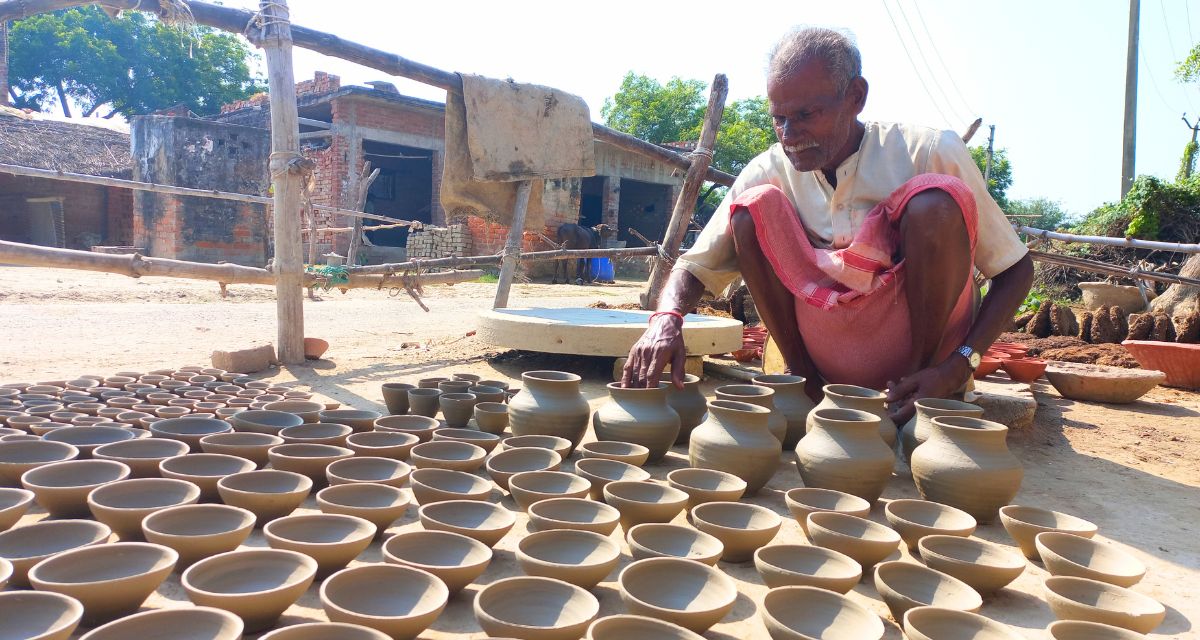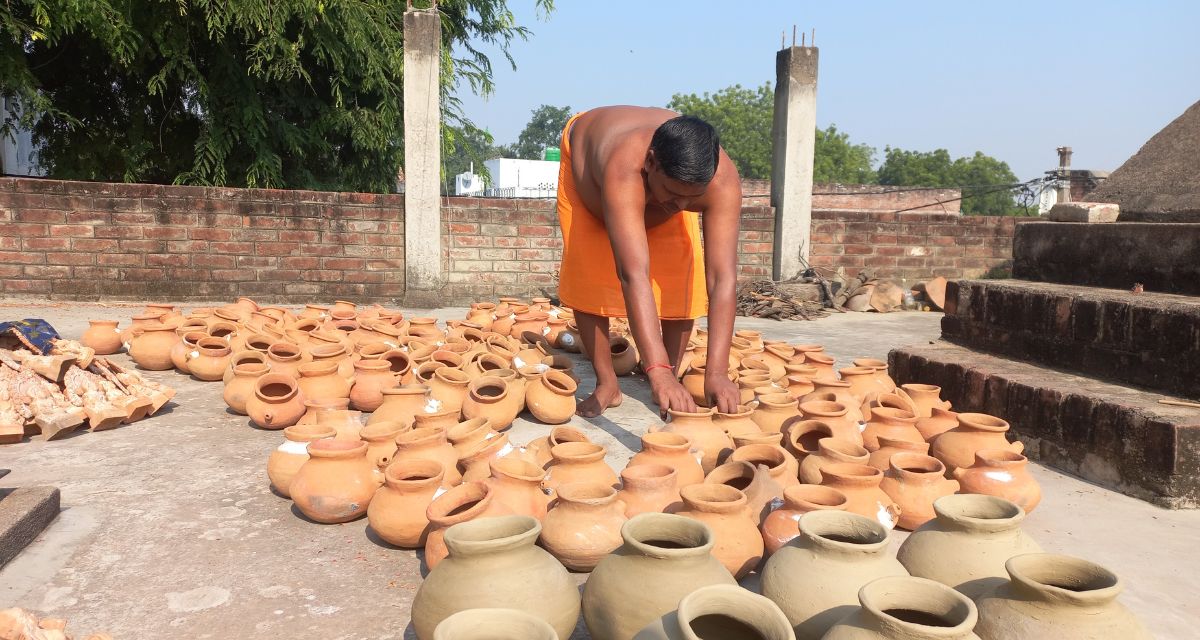Preference for plastic products, degradation of ponds and lack of awareness about government schemes make people shift from tradition
By Sumit Yadav
Unnao, Uttar Pradesh: Diwali is around the corner, and the few potters left in Unnao district of Uttar Pradesh are looking towards the festival to earn some extra money. ‘We hardly earn enough throughout the year, it is during the festival season that we can make some money by selling diyas [oil lamps] and other clay utensils,’ says Rajkumar Prajapati (42) of Korari Kala village of the district, while getting idols of Goddess Lakshmi and God Ganesh ready for Diwali.
‘My family of eight works together to get things ready for the festival. This helps in meeting our Diwali expenses. We usually rely on farming for our source of income, because it is difficult to support the family with just the money we get from pottery,’ says Rajkumar, whose sons are studying in classes 10 and 8.
‘I learnt pottery making from my father, but my sons will not take up this job. I also do not want my children to do this. There is no future in pottery,’ he says.
Pottery was a prominent occupation in rural areas, predominantly carried out by the Kumhar caste in the district. With the passage of time, pottery making slowly became obsolete. Only a handful of individuals are involved in this profession now as the new generation is looking at other career paths.
Take the example of Shankar Vishwakarma (80) of Rithanai village who says he is the last person in his family to make clay utensils. He has been working as a potter for over 70 years. His body has become frail now, and he can hear very little, but he says he will continue to do the work as long as he can because this is all he knows. ‘I have four sons — three work as masons and one is a teacher. Initially, two of my sons started working with me in pottery making, but they lost interest within a few days and looked for an alternative.’
Shankar explains that the younger generation is losing interest because the profession is not lucrative. ‘To make pots and other clay utensils, the entire family has to get together to procure clay, shape utensils, bake them and then finally sell them. Even today, our largest pot sells for Rs 50 to 60. The maximum it can fetch is Rs 80,’ he says.
‘A person can only earn about Rs 4,000 to 5,000 by making clay utensils, and there is no guarantee that we will make so much. It takes about five to six days for a pot to be ready. The money is not proportional to the effort it takes in making the utensils,’ he adds.
Shankar’s elder son and mason, Santlal Vishwakarma (55) chimes in. ‘From masonry, I get around Rs 700 daily, which is enough to cover the family’s expenses… I know that my children will not continue this family occupation and I agree with them. Even doing masonry for someone else is better than doing your pottery work alone,’ he says.


Non-availability of clay for pottery
In addition to low income, availability of clay is an issue. ‘We need fine clay to make utensils. This clay is found at about 6 to 8 ft depth in the water body. Earlier, before the onset of monsoon, we would collect the clay and store it in our homes. However, most of the ponds near the villages have vanished or the area has been taken over for farming purposes… The ponds that do exist are often filled with household waste, plastic and contaminated water. To get the right quality clay, we have to travel about 3 km or more,’ says Shankar.
He further explains that nearly 25 years ago, the government allocated 10 biswa (0.04 acre) to eight potters. However, the soil on that land was not suitable for pottery, so they did not collect clay from there. ‘Taking advantage of this, the nearby farmers encroached upon the land, so now we do not even have an option to collect soil from there or have a leverage against the government to show that the clay from the land is not suitable for pottery making,’ he adds.
The introduction of plastic has also brought down the popularity of pottery. ‘The pot that would sell for Rs 10 to 15 some 15 years ago now sells for Rs 50. But the price of everything has gone up exponentially,’ says Sarju Prasad (80), another potter from Rithanai village whose both sons work as masons.

A paradigm shift
Virendra Kumar Prajapati (34) from Rithanai teaches in a private school and runs a Common Service Centre where online services related to Aadhaar and job cards are available.
‘My father and grandfather used to do pottery, but now my father is engaged in agriculture and masonry. I had tried to get a government job but could not clear exams, so I started teaching in schools. I earn Rs 8,000 from teaching and the online centre fetches about Rs 6,000 to 8,000. Compare this to what our family earned when we used to do pottery to earn barely Rs 3,000 to 4,000,’ says Virendra.
Every village now has only two to four potters, says Santlal. Although there are government schemes in place to assist potters, these benefits have either not reached the intended recipients or the individuals are unable to utilise them.
Many older potters are unfamiliar with or find it challenging to use the government-subsidised electric wheels, preferring the traditional stone or iron wheels for their work. Integrating older artisans with new technology presents a significant challenge in this field.

What government says about the challenges faced by the pottery industry
Addressing the challenges faced by potters, former (now transferred) district khadi and village industries officer Akhilesh Agnihotri highlights the various ongoing government schemes intended to assist potters. Potters have the opportunity to apply for leases through the revenue department.
‘The department annually provides wheels, both manual and electric, to selected farmers at the block level to enhance the pottery business. Additionally, we extend loans at minimal interest rates to promote business growth. Despite these efforts, the number of potters registering with the department remains minimal,’ Agnihotri says. A total of 416 potters have registered with the District Khadi and Village Industries Board so far.
The new District Khadi and Village Industries Officer, Satyendra Kumar, mentions the range of government schemes aimed at supporting potters. ‘The primary scheme is the Chief Minister Mati Kala Rojgar Yojana, which offers bank loans ranging from Rs 1 lakh to Rs 10 lakh. The potters also receive technical training in a 15-day programme to enhance their skills and are educated about new techniques and opportunities in the field of pottery,’ he says.
‘But, it is true that due to lack of awareness, many potters are not able to receive the benefit of the schemes,’ Kumar adds. The department has plans to raise awareness through posters and wall paintings at the block level.
Sumit Yadav is an Uttar Pradesh-based freelance journalist and a member of 101Reporters, a pan-India network of grassroots reporters.
About the author(s)
101Reporters is a pan-India network of grassroots reporters that brings out unheard stories from the hinterland.






